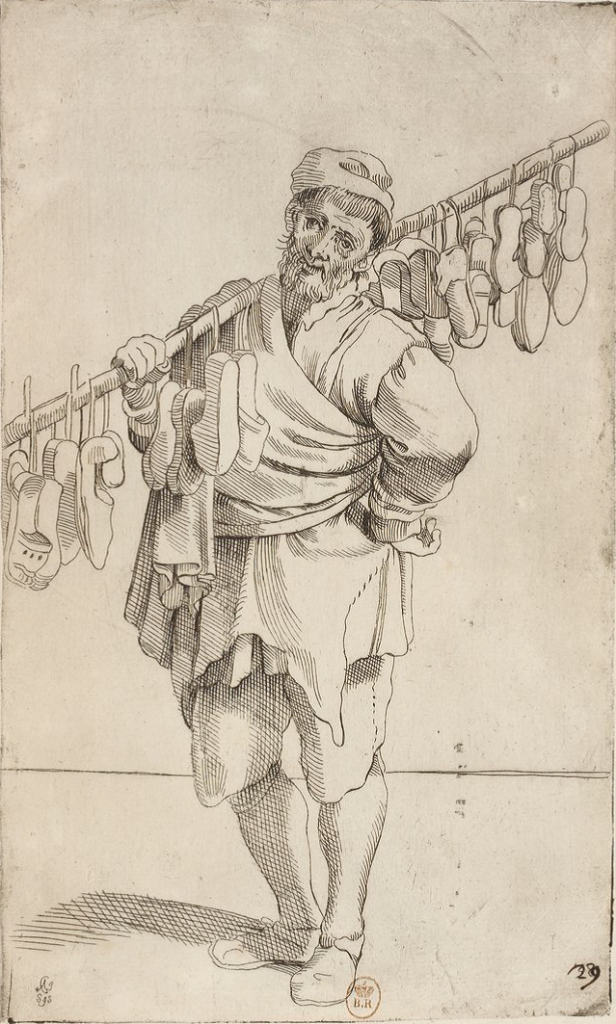Rachel Willie discusses the songs of the street and introduces a new research network, ‘Soundscapes in the Early Modern World’.


A recent special issue of the SRS’s journal, Renaissance Studies on street singers in Europe has illustrated the ways in which an itinerant community moved between city and country singing news, politics, opinions, stories and sharing ‘knowledge’. In the city, the songs of street singers blended with the cries of the merchants who shouted out to sell their wares: composers such as Orlando Gibbons (1583-1625) set the cries to music and images such as those in the Arti di Bologna series by Annibale Carracci (1560-1609) captured the bustle of the street vendors. The noisiness the city comes through in these sounds and images and this is also reflected in ‘Of Caius’, by the little-known Elizabethan poet, Edward Guilpin (c. 1572-1601). In this epigrapm, Guilpin presents the eponymous hero as walking the streets of London, crying out in delight at all he sees:
As Caius walks the streets, if he but heare
A blackman grunt his note, he cries oh rare!
He cries oh rare, to heare the Irishmen
Cry pippe, fine pippe, with a shrill accent, when
He comes at Mercers chappell; and, oh rare,
At Ludgate at the prisoners plaine-song there:
Oh rare sings he to heare a Cobler sing,
Or a wassaile on twelfe night, or the ring
At cold S. Pancras church; or any thing:
He’le cry, oh rare, and scratch the elbow too
To see two Butchers curres fight; the Cuckoo,
Will cry oh rare, to see the champion bull,
Or the victorious mastife with crown’d scull:
And garlanded with flowers, passing along
From Paris-garden he renewes his song,
To see my L. Maiors Henchmen; or to see,
(At an old Aldermans blest obsequie)
The Hospitall boyes in their blew aequipage,
Or at a carted bawde, or whore in cage:
He’le cry, oh rare, at a Gongfarmers cart,
Oh rare to heare a ballad or a fart:
Briefely so long he hath vsde to cry, oh rare,
That now that phrase is growne thin & thred-bare,
But sure his wit will be more rare and thin,
If he continue as he doth begin.Edward Guilpin, ‘Of Caius, 68’, in “Skialetheia. Or, A shadowe of truth, in certaine epigrams and satyres” (London, 1598), sigs. A2r-A2v
The name ‘Caius’ means ‘rejoice’, and part of the joke as relayed by the curmudgeonly narrator is the way in which Caius lacks discernment and rejoices indiscriminately in all he sees and hears. The presentation of the cries of the city meeting the cries of the naïve visitor to London is laden with Renaissance stereotypes and prejudices about migrants and ne’er do wells. It is an everyday scene and its mundane quality is emphasised by the pitch and tone of the various voices that cry out. However, the city is not only noisy: the bull, festooned with flowers, and the unspecified flatulent odours each add to the fragrances of the space. Walking through the city is a multi-sensory experience where sights, smells and tactility can delight the walker. Knitting together these sensations are the sounds created by what is seen, touched and sniffed. This is underscored by the striking use of musical imagery: the cacophonous sounds of the city present us with a bustling cityscape. Plaintive songs from the prison harmonise with the plain song from the church and Caius’s cries of ‘oh rare’ form a refrain that punctuates the other noises. There is a musicality to the urban setting, which Guilpin emphasises through the metaphorical use of song. The epigram thus presents a youth who walks the city, expressing his amazement at the noisy, everyday occurrences that take place in the diverse and cosmopolitan space of early modern London. The city is understood and presented through sound, and this raises questions about how we might understand the relationship between sound and space in the Renaissance; these questions will be explored in a new interdisciplinary research network.
‘Soundscapes in the Early Modern World’ establishes an international network of scholars working on the period from c. 1500-1800 to develop new approaches to uncovering the sounds of the early modern world. Our focus is on how sonic interaction shapes early modern identities. From the chiming of the clock regulating the daily patterns of the city, to the bell calling all to church, the street singer, and the literate reading pamphlets to the illiterate, sounds governed everyday life. The network will explore how sounds create communities, civil society, sociability and ways of knowing and understanding the wider world and the self.
Rachel Willie is Senior Lecturer in English Literature and Cultural History at Liverpool John Moores University. With Emilie Murphy (Lecturer in History at the University of York), she is lead investigator on the AHRC-funded research network, ‘Soundscapes in the Early Modern World’.
For further information about this network, see the project website: emsoundscapes.co.uk.
